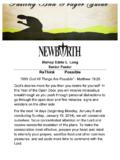Transcription of Eddie Bell NEUTEC USA, Albuquerque, New Mexico USA
1 Eddie bell NEUTEC USA, albuquerque , New Mexico USA. Eddie bell is the President of NEUTEC USA and founder of the Santa Fe Symposium on Jewelry Manufacturing Technology. He is an expert in the goldsmith industry, and is considered one of the most highly qualified experts in the process of lost wax casting. He participates at the most important international gold conferences, consistently presenting original papers from a very practical approach. There are many false beliefs regarding precious metal loss during casting. But are these always actual losses? And if they are not losses, where is the gold going?
2 This paper will discuss these points, and will give suggestions on how to reduce precious metal losses. Controlling Melt Loss when Melting Gold Alloys Introduction There are many misconceptions surrounding melt loss. We are often asked how much melt loss is normal or how to recover the gold that is lost during melting. Just about anyone who has cast gold has experienced melt loss. In the simplest terms, melt loss is a shortage in the total weight recovered versus the total weight melted. Melt losses can occur in any melting operation including smelting, alloying, casting and grain making, but is the gold really lost?
3 If it isn't lost, where is it and can it be recovered? And most importantly, what can be done to minimize melt loss? The goal of this paper is to discuss the various causes for missing metal (aside from theft). and suggest some solutions. Causes for Melt Loss The three melting operations common to most casting shops are alloying, melting sprues and other clean scrap to make casting grain, and casting. Following are 11. areas that need to be managed to control and minimize melt loss. Porous Crucible It is possible for a caster to experience a large loss from a high karat alloy containing no zinc and very small loss from a high zinc, low karat alloy.
4 How can this be, you might ask, for the reverse would seem more logical, wouldn't it? Gold will seep into pores too small to see in any kind of crucible, ceramic or graphite, but the problem is seen more often with graphite crucibles bought for a little less by someone thinking they are saving money. Cheap graphite is no bargain if it sucks up some of your gold. Don't get the idea that ceramic crucibles are better; graphite is still the preferred crucible material for gold and silver; you just need a high grade of graphite. It turns out that the higher the gold content in an alloy, the denser the crucible needs to be.
5 Gold can be recovered from graphite crucibles by burning them in your burnout oven while ceramic crucibles require the services of a refiner. Flux Flux is used to reduce the amount of slag produced during melting and to make the metal more June 2004 197. Usually we use fluxes that are based on boric acid or borax that melt below the liquidus of gold and silver alloys and make a glassy film on the metal. In open melting condition this film serves to protect the metal from air, and by preventing oxidation will greatly reduce zinc loss2. Impurities in the metal can be removed by flux, however the metal would have to be badly contaminated before the weight difference could be measured on normal scales.
6 Little beads of metal can be caught in flux and remain in the crucible. The more viscous the flux is and the thicker the flux layer, the more likely some metal will be trapped. Also the low karat alloys are more likely to be trapped and silicon alloys seem to stick to flux better than alloys without silicon. This is not normally a problem with modern closed casting systems because flux is not necessary and therefore not used. Casters who use centrifugal casting machines might see odd variations in weight such as weight loss on three or four trees and then weight gain on the next tree.
7 This odd variation can be easily explained: if the flux is not skimmed before casting, you can get flux inclusions in the tree that will give it weight gain. Beads of metal trapped in the flux will make the cast tree a little light. With subsequent melts little beads of trapped metal combine making larger beads that eventually are cast out making that tree weigh a little more than the charge. If the flux is water soluble, boric acid, metal can be recovered from the flux in crucibles by boiling the crucible in water until the flux is dissolved and then filtering the metal out of the water.
8 The kind of flux, the amount of flux used, the condition of the alloy and the kind of alloy all can have an influence on how flux contributes to apparent melt loss. The word apparent is used because flux is not really responsible for melt loss but needs to be managed. Boron and Silicon Silicon is added to gold alloys to reduce the sensitivity to oxygen and increase fluidity3. It is not soluble in gold or silver, so the amount of silicon in a gold alloy is dependent on the amount of copper there. Silicon is much more active to oxygen than copper or zinc. It protects the melt by combining with any oxygen available to become silicon dioxide (silica), which precipitates leaving a visible glassy slag in the crucible and an invisible layer on the surface of the casting.
9 Obviously, whatever precipitates will be missing when the metal is weighed after casting and a melt loss can be recorded. Silicon was originally added to gold alloys to solve casting problems that are the result of melting and pouring them in the presence of air, forming oxides of copper and nickel4. In open systems where air is present and gold alloys containing silicon are melted and poured it is expected that about 20% of the silicon will be lost. The silicon loss rate is very process dependent where higher temperatures and longer exposure to air will increase the amount lost.
10 Open melt processes are usually not very repeatable so the silicon loss is likely inconsistent. In any case, the depletion of silicon causes the alloy to become gold enriched to some extent. When alloys intended for open melting are cast in a closed casting machine that is absent of air or oxygen, the silicon does not get used up at the expected rate. 198 Jewelry Technology Forum Because zinc is lost and it is possible for the silicon content to go up when the metal is recycled several times. Silicon enrichment can have several bad effects including brittleness, hard spots, non-filling5 and coarse grain.







